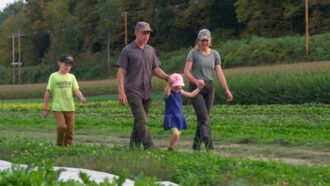On the banks of the White River, Hurricane Flats Farm is finding new ways to thrive in the face of increasingly unpredictable weather. In a new episode of America’s Heartland, produced in partnership with SARE, farmers Ashley Loehr and Antoine Guerlain share how they’re navigating both severe drought and catastrophic flooding on their 37-acre certified organic farm in Vermont.
After taking over the farm, Loehr and Guerlain faced intense droughts during their first three seasons and devastating floods in 2023 that destroyed 75% of their projected gross income. “Droughts, floods, extremely heavy rain, extreme wind, all those things are happening all the time, and could happen any minute,” says Loehr.
To manage these challenges, they’ve adopted a range of innovative farming techniques. By planting strip crops and buffer zones, grouping high-value crops away from high-risk flood zones, and choosing a diverse mix of short-cycle and long-season crops, they’ve built flexibility into their growing season. These strategies allow them to reduce losses and recover faster when weather disrupts production.
Hurricane Flats also partners with the White River Partnership to grow 1,000 young trees that will be transplanted onto farms across the region—strengthening riparian areas and supporting long-term soil health and water quality. The farm’s produce is sold directly to the community at farmers’ markets, where the support for their efforts has been strong.
This video is part of an episode of RFD-TV's America's Heartland produced by PBS KVIE highlighting farmers and ranchers who are using sustainable strategies to adapt to challenging weather conditions. View the entire episode at Farming Strategies for Adapting to Extreme Weather.
